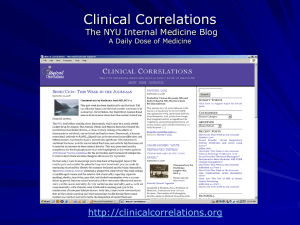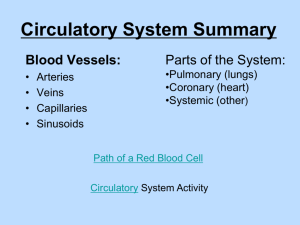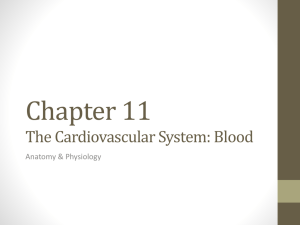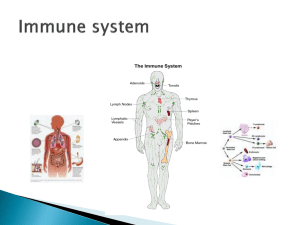A Sequence Building Approach to Pattern Discovery in Medical Data
advertisement
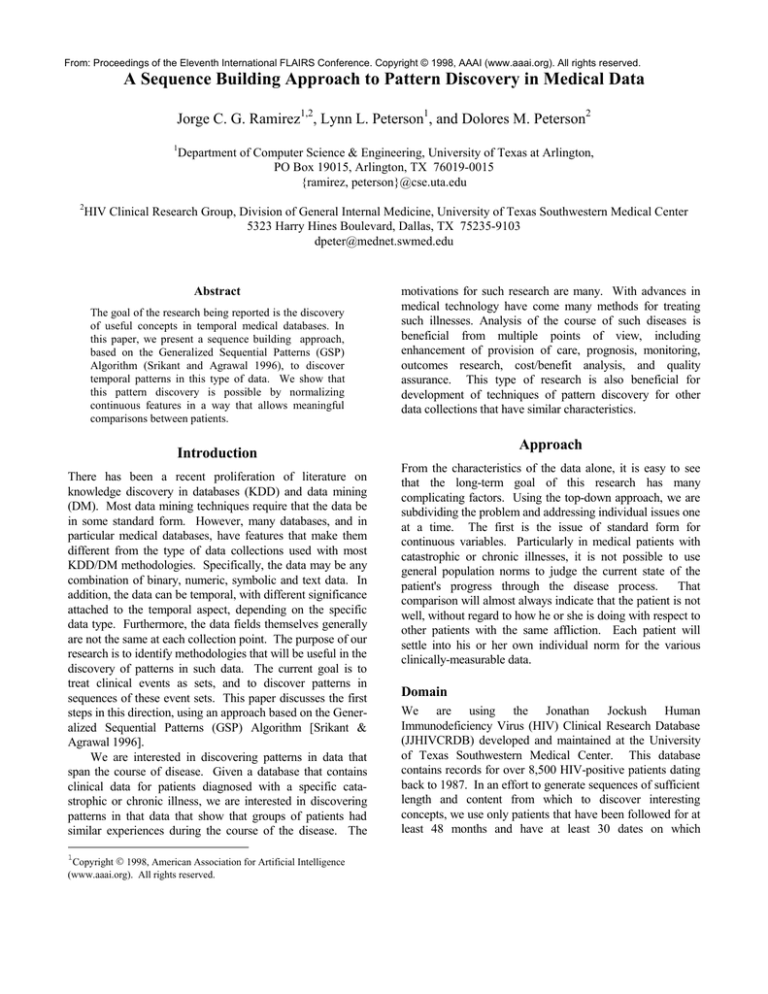
From: Proceedings of the Eleventh International FLAIRS Conference. Copyright © 1998, AAAI (www.aaai.org). All rights reserved.
A Sequence Building Approach to Pattern Discovery in Medical Data
Jorge C. G. Ramirez1,2, Lynn L. Peterson1, and Dolores M. Peterson2
1
Department of Computer Science & Engineering, University of Texas at Arlington,
PO Box 19015, Arlington, TX 76019-0015
{ramirez, peterson}@cse.uta.edu
2
HIV Clinical Research Group, Division of General Internal Medicine, University of Texas Southwestern Medical Center
5323 Harry Hines Boulevard, Dallas, TX 75235-9103
dpeter@mednet.swmed.edu
Abstract
The goal of the research being reported is the discovery
of useful concepts in temporal medical databases. In
this paper, we present a sequence building approach,
based on the Generalized Sequential Patterns (GSP)
Algorithm (Srikant and Agrawal 1996), to discover
temporal patterns in this type of data. We show that
this pattern discovery is possible by normalizing
continuous features in a way that allows meaningful
comparisons between patients.
motivations for such research are many. With advances in
medical technology have come many methods for treating
such illnesses. Analysis of the course of such diseases is
beneficial from multiple points of view, including
enhancement of provision of care, prognosis, monitoring,
outcomes research, cost/benefit analysis, and quality
assurance. This type of research is also beneficial for
development of techniques of pattern discovery for other
data collections that have similar characteristics.
Approach
Introduction
There has been a recent proliferation of literature on
knowledge discovery in databases (KDD) and data mining
(DM). Most data mining techniques require that the data be
in some standard form. However, many databases, and in
particular medical databases, have features that make them
different from the type of data collections used with most
KDD/DM methodologies. Specifically, the data may be any
combination of binary, numeric, symbolic and text data. In
addition, the data can be temporal, with different significance
attached to the temporal aspect, depending on the specific
data type. Furthermore, the data fields themselves generally
are not the same at each collection point. The purpose of our
research is to identify methodologies that will be useful in the
discovery of patterns in such data. The current goal is to
treat clinical events as sets, and to discover patterns in
sequences of these event sets. This paper discusses the first
steps in this direction, using an approach based on the Generalized Sequential Patterns (GSP) Algorithm [Srikant &
Agrawal 1996].
We are interested in discovering patterns in data that
span the course of disease. Given a database that contains
clinical data for patients diagnosed with a specific catastrophic or chronic illness, we are interested in discovering
patterns in that data that show that groups of patients had
similar experiences during the course of the disease. The
1
Copyright 1998, American Association for Artificial Intelligence
(www.aaai.org). All rights reserved.
From the characteristics of the data alone, it is easy to see
that the long-term goal of this research has many
complicating factors. Using the top-down approach, we are
subdividing the problem and addressing individual issues one
at a time. The first is the issue of standard form for
continuous variables. Particularly in medical patients with
catastrophic or chronic illnesses, it is not possible to use
general population norms to judge the current state of the
patient's progress through the disease process.
That
comparison will almost always indicate that the patient is not
well, without regard to how he or she is doing with respect to
other patients with the same affliction. Each patient will
settle into his or her own individual norm for the various
clinically-measurable data.
Domain
We are using the Jonathan Jockush Human
Immunodeficiency Virus (HIV) Clinical Research Database
(JJHIVCRDB) developed and maintained at the University
of Texas Southwestern Medical Center. This database
contains records for over 8,500 HIV-positive patients dating
back to 1987. In an effort to generate sequences of sufficient
length and content from which to discover interesting
concepts, we use only patients that have been followed for at
least 48 months and have at least 30 dates on which
Table 1. Results of Normalization Procedure Applied to White Blood Cell (WBC) Count
a. HIV patient,
clinically deteriorated
Normalized
Value
Actual
WBC Range
-4
-3
-2
-1
0
+1
+2
+3
+4
up to 1.3
1.4 - 2.0
2.1 - 2.7
2.8 - 3.4
3.5 - 5.2
5.3 - 6.4
6.5 - 7.7
7.8 - 8.9
9.0 and up
b. Norms,
general population
Normalized
Value
-4
-3
-2
-1
0
+1
+2
+3
+4
laboratory data was collected. There are approximately 1100
such patients in the database. For our early experiments we
used a random subset of this group of patients.
Normalization of Laboratory Results
White Blood Cell Count. Specifically, we started by examining white blood cell (WBC) count in patients with HIV,
which may or may not have progressed to Acquired Immune
Deficiency Syndrome (AIDS).
Standardizing values
between event types is not the issue; standardizing values
between patients is. What is normal for one patient can
range from normal to very poor for another patient. Using
standard statistical techniques, we developed a methodology
for normalizing WBC counts to a range of -4 to +4 where 0
is normal, and both -4 and +4 are indicative of severe illness.
The choice of -4 to +4 was made to represent the
approximate number of standard deviations away from the
“normal” average. The methodology is based on norms for
the general population with adjustments made for the fact
that HIV compromised patients tend to have lower than
normal values. However, the methodology takes into account the fact that the normal value for any given patient may
be different, or not, compared to the general population.
A comparison of results is shown in Table 1. The
general population norm is shown in Table 1b. This can be
compared to the results obtained by using our methodology
on a clinically deteriorated patient in Table 1a, and a healthy
HIV patient in Table 1c. Notice that “normal” (i.e., 0) for
our clinically deteriorated patient is 3.5 to 5.2, which is poor
(i.e., ranging from -3 to -2) compared to the general
population; however “normal” for our relatively normal
patient is 6.3 to 8.6 which is almost exactly the same as the
range for the general population.
c. HIV patient,
relatively normal
Actual
WBC Range
Normalized
Value
up to 2.9
3.0 - 4.0
4.1 - 5.1
5.2 - 6.3
6.4 - 8.6
8.7 - 9.8
9.9 - 10.9
11.0 - 12.0
12.1 and up
-4
-3
-2
-1
0
+1
+2
+3
+4
Actual
WBC Range
up to 2.5
2.6 - 3.7
3.8 - 5.0
5.1 - 6.2
6.3 - 8.6
8.7 - 9.8
9.9 - 11.1
11.2 - 12.3
12.4 and up
Generalization. WBC is a member of a class of clinical
data with the following characteristics: 1) some median
value is normal and therefore good; 2) a significant increase
in value is a clinical indication of a disease process in action;
and 3) a significant decrease in value is also indicative of a
problem with the patient's health status. Given the number of
features involved, it would not be expedient to do such a
detailed analysis on every individual variable. We chose to
analyze all variables with the same characteristics as a group.
Taking the specific numbers that were used in the WBC
equations and relating them back to how they were
developed, i.e., by parameterizing the equations, generic
equations were created to attempt analysis on other data of
the same class. We applied these parameterized equations to
a few chosen features that are members of the same class of
clinical data as WBC: Hematocrit (HCT), Platelets (PLT),
CD-4 percent (CD4P), CD-4 absolute (CD4A), and Lymphocytes (LMPH) with results similar to those for WBC. When
the results were reviewed by the clinicians in the HIV
Clinical Research Group, they were impressed that the results
matched up with their clinical experiences.
Event Set Sequences
The basic approach for organizing our data involves the use
of sets of data which are grouped by date and include
treatments and measures of health status. The algorithm
iteratively searches for sequences of event sets common to
multiple patients. Temporal windows are used to group
together related events that occur close to each other but not
on the same date. Formalizing this algorithm uses the notion
of Event Set Sequences (ESSs) of patient data, of which the
formal definition is given below.
< {HCT 0 PLT 0 CD4P 0
{PLT 0} {WBC 0 HCT 0
{WBC 0} {WBC 0 HCT 0
CD4A 0 LMPH -1} {WBC 0 HCT 0}
PLT 0 CD4P 0 CD4A 0 LMPH 0}
PLT 0} {HCT 0} {WBC 0} {WBC 0} >
Figure 1. Discovered Pattern. Uses 6 event types, 33% support threshold and 90 days maximum gap.
Contains 9 clinical event sets, potentially spanning over 2 years.
Definitions
Let O = {O1, ..., Oj} be the set of occurrence events, where
Oi has duration di ∈ DOi, the set of possible durations of Oi.
Let V = {V1, ..., Vk} be the set of value events, where Vi has
domain DVi, the set of possible values of Vi. Let e = (id, t,
E, v) be an event, a four-tuple where id is the patient, t is the
time of e, E ∈ (O ∪ V), and if E ∈ O, specifically Oi, then v
∈ DOi, otherwise E ∈ V, specifically Vi, and v ∈ DVi. Let
ES = {e1, ..., em} be an event set, a non-empty set of events,
where id1 = ... = idm, and t1 = ...= tm. Let IDi (= id1 = ... =
idm) be the actor for ESi, and Ti (= t1 = ... = tm) be the time
of ESi. Finally, let ESS = < ES1, ..., ESn > be an event set
sequence, an ordered list of event sets where ID1 = ... =
IDn, and T1 < ... < Tn.
In our domain, O contains pharmacy events (i.e., the
dispensing of medications) and diagnosis events (e.g., a
pneumonia), and V includes charge events (e.g., for clinic
visits or hospital stays) and laboratory-test-result events
(e.g., white blood cell count). Time is measured in days;
therefore, each Event Set (ES) is a collection of those
events that occur on a specific day. Finally, an Event Set
Sequence (ESS) is an ordered list of Event Sets for a given
patient.
We seek to discover patterns in ESSs such that there is a
similarity among patients in at least a sub-sequence of the
sets of events. We say that a pattern is discovered for a
group of ESSs if we can find some sequence Si = <s1, …,
sq> for each ESSi, where si denotes the subscript of an ES,
1 ≤ s1 < … < sq ≤ n, q is equal for all ESSi in the group, and
each ES of the corresponding sequence “matches” across
all ESSi. The definition of “match” is therefore crucial to
the discovery process. While this definition is continually
being reviewed, in the current model we define ES′ ⊆ ES,
where all e | e ∈ ES′ match exactly across all ESSs;
however, the definition does not require all e ∈ ES be
present in ES′. Further, we use a windowing technique, as
in the GSP algorithm, that allows for events that do not
actually occur on the same day, but occur within the
specified amount of time, to be included as part of the same
ES or ES’.
Pattern Discovery
We developed a variation of the GSP Algorithm to discover
patterns in our domain. Though the basic algorithm is the
same, the details of implementation are different. The GSP
algorithm was designed to work on sequences of events that
either occurred or did not, where the occurrence or lack
thereof was significant to the patterns discovered. None of
the events had attributes.
The differences in domains leads to several significant
observations, particularly for future work. In our domain, the
occurrence or lack thereof does not have any specific
significance.
The events themselves have attributes,
especially when viewed from the event set perspective.
Finally, the shear numbers of events being dealt with strains
an algorithm that was designed to discover patterns at an
individual event level.
Results
Initially, we ran our modified GSP Algorithm on a random
sample of six patients who had all been followed for 60-65
months and had 30-39 dates during that time period in which
clinical data was collected. As it turned out, of the original
six patients, two of them were particularly "well" over the
time period and therefore, the longest sequences that were
discovered were for groups of patients that were well.
However, we believe that once we pull more patient data
from the available 1000+ patients that have been followed
for a minimum of 48 months, with a minimum of 30 clinical
event days, we will ultimately discover patterns for groups of
patients with varying clinical patterns. For example, one
experiment (where 6 event types (or features), a support
threshold of 33%, and a maximum gap of 90 days between
clinical event sets was used) resulted in the pattern shown in
Figure 1 being discovered.
This pattern represents 9 clinical event sets that are
supported by the database, where the first one matches on
five of the six features, the second matches on two of the
features, etc. Notice that the fourth event set matches on
all six features and that the entire pattern represents a
"well" patient over the period since nearly all of the
standardized values are 0. This result does not mean that
the patients that supported this pattern did not have periods
when they were not as well, but that if they did, they did
not have it in a sequence that paralleled the other patients
that supported this particular pattern. Given the parameters
used for this experiment, this particular pattern potentially
spans over 2+ years.
Effects of Varying Parameters on Pattern Length
We have varied many parameters of the algorithm to get a
feel for which ones have the most effect on the length and
interestingness of patterns discovered, as well as the
amount of time taken to discover those patterns. Gut
instinct is borne out by the numbers; as the parameters
allow for longer sequences to be discovered, the time for
the discovery increases. The patterns are generally longer
when more features are available to choose from, when the
support threshold is lower and when the maximum gap is
higher. Our initial experiments used the GSP Algorithm
and a single feature, WBC. However, we have now
modified the algorithm to incorporate any number of
standardized features.
Support. Support is the percentage of all patients whose
ESS actually contains a given pattern. Srikant and Agrawal
employed a 40% support threshold in their domain. Since
we started with 6 patients, we used 50% and 33% in our
initial experiments. As expected, the 33% threshold
consistently resulted in longer patterns. When the same
experiment as shown in Figure 1 was run with a 50%
threshold, as opposed to the 33% threshold, it resulted in
the shorter pattern shown in Figure 2.
Inversely, the amount of time taken to discover patterns is
less when there are fewer features being used, when more
support is required from the database, and when the
maximum gap allowed between clinical events is smaller.
One result, though not surprising, is that we have
experienced an exponential explosion in time when we
decrease the support required and increase the maximum
gap. We have made a few modifications and improved
times over our initial experiments; however, goal directing
techniques will need to be incorporated to prevent
exhaustive searches that take an unsatisfactorily long time.
Table 2 shows a comparison of the computation time
in terms of CPU seconds and nodes searched for
Table 2. Computation Time/Nodes Searched for
Max Gap = 90 Days
a. Threshold = 50%
# Features
3
4
5
6
Time(CPU Secs)/
Nodes Searched(100,000s)
6 Patients 12 Patients 24 Patients
9 / 11
4/6
352 / 262
15 / 17
5/7
371 / 278
32 / 37
6/8
448 / 336
7/9
638 / 462
b. Threshold = 33%
< {PLT
{WBC
{WBC
{WBC
{HCT
0
0}
0
0}
0}
CD4P 0 CD4A 0}
{PLT 0}
PLT 0 CD4P 0}
{HCT 0 PLT 0}
>
Figure 2. Shorter Discovered Pattern. Uses 50%
support threshold, instead of 33%. The
increased threshold requirement reduces the
length of the pattern.
Maximum Gap. Since even an HIV patient who is doing
relatively well sees the doctor at least every 2-3 months, we
started with a maximum gap of 90 days; however, there
was a significant difference in pattern length when we
increased that gap to 120 days. If a patient has a gap in his
or her ESS longer than the maximum gap, then it has the
effect of partitioning that patient’s ESS into subsets. The
likelihood of a longer pattern being supported by that
patient is therefore decreased. However, if there are no
gaps in the ESS longer than the maximum gap, then that
patient is more likely to support longer patterns.
Computation Time
# Features
3
4
5
6
Time(CPU Secs)/
Nodes Searched(100,000s)
6 Patients 12 Patients 24 Patients
102 / 66
64 / 77
9341 / 6102
345 / 152
72 / 91
Not Available
3858 / 914 93 / 118
Not Available
112 / 144
Not Available
experiments where the maximum gap is 90 days, the
threshold is 33% or 50%, the number of event types
included varies from 3 to 6, and the number of patients is 6,
12 or 24. There is a linear-order increase in computation
time as more event types (features) are added. The
exception is the 6 patient group when the addition of the 5th
feature (CD4 Absolute) caused a dramatic increase. We
believe this was an aberration due to the small sample size,
and the fact that this particular feature is collected
frequently in HIV/AIDS patients. Compared to the 6
patient group, computation time dipped for the 12 patient
group, then increased alarmingly for the 24 patient group.
Again we believe the dip was an aberration, this time
attributable to the specific group of 12 patients involved.
Interestingness
Goal directing techniques will also need to be used to
prevent discovery of long patterns of relatively low
interest, though the issue of interestingness is yet to be fully
explored. An example of a pattern that might be more
interesting is shown in Figure 3:
< {WBC 0} {HCT -4} {PLT 0}
{WBC 4} {WBC 1} >
Figure 3. Potentially More Interesting Pattern. This
pattern alternates between periods of
wellness and illness.
The pattern seems to alternate between periods of wellness
and periods of illness. This pattern was discarded after
there was not support in the database to carry it out further.
This fact leads us to believe that in order to discover
patterns with some interestingness to them, we will need to
drop the support threshold, since we are in fact interested
in groups, which are not necessarily large, with similar
course of disease.
was determined based on exact match, which cannot work in
the medical data domain.
Conclusions and Future Work
Though the current results are somewhat interesting, the
modified GSP Algorithm does not actually accomplish our
long-term goal. As currently implemented, the algorithm
requires that all features be present to support the pattern;
however, since the set of recorded data that exists for each
patient not only varies greatly between patients, but also
varies between collection dates for any given patient, our
next goal is further modifications to account for missing
data. Our event set strategy should help to address this
issue and reduce the computational complexity as well.
Currently every individual event is analyzed for support of
a pattern. By comparing event sets at the set level, we
believe that computational complexity will decrease
significantly.
Other future goals include the
aforementioned investigation into interestingness of
discovered patterns, which will include dropping the
support threshold, adding goal directing, and the incorporating temporal aspects of features not included in this work
(e.g., the duration of a diagnosis or a treatment).
Related Work
Acknowledgments
(Mannila, Toivonen and Verkamo 1995) address the
temporal aspect of discovery, locating frequently occurring
episodes (i.e., combinations of events with a partially
specified order) from a long sequence of events. (Mannila
and Toivonen 1996) extend the technique to include
specification of order of events and discovery of general
episodes. Padmanabhan and Tuzhilin also extend (Mannila,
Toivonen, and Verkamo 1995), noting that the work applies
to sequences, introduce temporal logic as an appropriate
formalism for expressing temporal patterns in categorical
data, and then use it as a means to discover patterns in
temporal databases. Of course, (Srikant and Agrawal 1996)
present the GSP algorithm that incorporates time constraints
to specify maximum and/or minimum time gaps between
adjacent elements of a sequential pattern. Further, they
generalize the definition of the patterns to incorporate
taxonomies in the data.
While all of this work is related, and certainly we use the
basic approach of the GSP algorithm, the domains are much
more restricted and lack the complexities of the medical data
domain. Specifically, the example domains used had specific
meaning to the occurrence or lack of occurrence of an event.
This is not true in our domain. The lack of occurrence of a
given event during a given event set does not necessarily
have specific meaning, other than the fact that that event was
not recorded at that time. Further, the occurrence of a given
event may not have specific meaning. While some of the
domains had attributes associated with the events, support
Jorge Ramirez is supported in part by NSF grant GER9355110.
References
Mannila, H., H. Toivonen, and A.I. Verkamo. 1995.
Discovering Frequent Episodes in Sequences. Proceedings,
1st International Conference on Knowledge Discovery and
Data Mining, p 210.
Mannila, H. and H. Toivonen.
1996.
Discovering
Generalized Episodes Using Minimal Occurrences.
Proceedings, 2nd International Conference on Knowledge
Discovery and Data Mining, p 146.
Padmanabhan, B. and A. Tuzhilin. 1996. Pattern Discovery
in Temporal Databases: A Temporal Logic Approach.
Proceedings, 2nd International Conference on Knowledge
Discovery and Data Mining, p 351.
Srikant, R. and R. Agrawal. 1996. Mining Sequential
Patterns: Generalizations and Performance Improve-ments.
Proceedings, 5th International Conference on Extending
Database Technology, p. 3.
